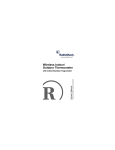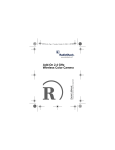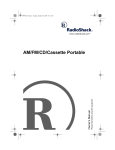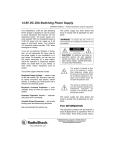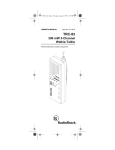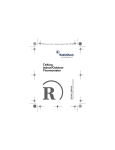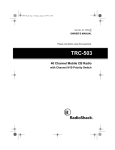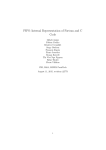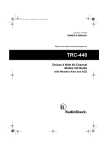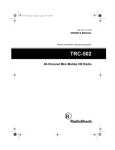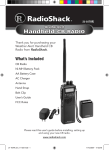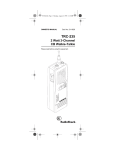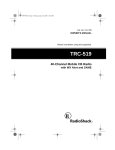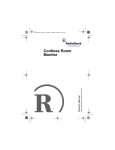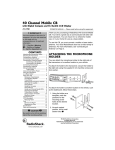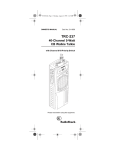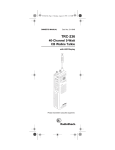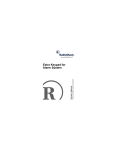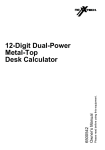Download Radio Shack 21-1679 A Owner`s manual
Transcript
21-1679r.fm Page 1 Wednesday, October 18, 2000 2:14 PM Compact Deluxe CB Walkie-Talkie Please read before using this equipment. Owner’s Manual with Digital Weather Alert 21-1679r.fm Page 2 Wednesday, October 18, 2000 2:14 PM ˆ Contents Features ........................................................................................................... 4 A Look at Your Walkie-Talkie .......................................................................... 6 Preparation ...................................................................................................... 7 Powering the Walkie-Talkie ........................................................................ 7 Using the Ni-MH Battery Pack ............................................................ 7 Using the AA Battery Case ................................................................. 8 Using AC Power .................................................................................. 9 Using Vehicle Battery Power ............................................................... 9 Connecting an Antenna ........................................................................... 10 Connecting an Optional Antenna ...................................................... 10 Connecting an External Speaker ............................................................. 11 Connecting an External Speaker/Microphone .......................................... 11 Operation ....................................................................................................... 12 Receiving Transmissions and Adjusting Squelch .................................... 12 Transmitting ............................................................................................. 12 Turning the Back Light On/Off .................................................................. 13 Turning the Key Tone On/Off .................................................................... 13 Using the Key Lock .................................................................................. 13 Using Channel 9/19 .................................................................................. 13 Scanning the Channels ............................................................................ 14 Power Save .............................................................................................. 14 Listening to the Weather Band ................................................................. 14 Listening to a Weather Channel ........................................................ 14 Turning Digital Weather Alert On/Off ................................................ 14 Understanding Digital Weather Alert ................................................. 15 Operational Hints .......................................................................................... 16 Common Uses For a CB .......................................................................... 16 Business Uses .................................................................................. 16 Personal Uses .................................................................................. 16 Transmission Courtesy ............................................................................ 16 Maximum Range ...................................................................................... 17 Using Common10-Codes ......................................................................... 17 Care ................................................................................................................ 18 Specifications ................................................................................................ 19 © 2000 RadioShack Corporation. All Rights Reserved. RadioShack, RadioShack.com, and Adaptaplug are trademarks used by RadioShack Corporation. 2 21-1679r.fm Page 3 Wednesday, October 18, 2000 2:14 PM ˆ The FCC Wants You to Know The Federal Communications Commission (FCC) does not require you to have a license to operate this CB. However, the FCC does require that you read and know Part 95 of FCC Rules. These rules apply to the operation of a Class D CB. We have provided a copy of these regulations with your CB. Warning: Do not open your CB to make any internal adjustments. Any internal adjustments can be made only by an authorized service technician. Unauthorized internal adjustments and/or modifications can lead to illegal operation as defined by Part 95 of FCC Rules. Such illegal operation can lead to very serious consequences. Your CB might cause TV or radio interference even when it is operating properly. To determine whether your CB is causing the interference, turn off your CB. If the interference goes away, your CB is causing it. Try to eliminate the interference by either moving your CB away from the receiver or contacting your local RadioShack store for help. If you cannot eliminate the interference, the FCC requires that you stop using your CB. 3 21-1679r.fm Page 4 Wednesday, October 18, 2000 2:14 PM ˆ Features Your RadioShack Compact Deluxe CB Walkie-Talkie is a high performance CB transceiver that also lets you tune into local weather service broadcasts, letting you hear local weather conditions and forecasts wherever you travel. This walkie-talkie is perfect for recreational, business, or emergency use. You can call other people who have CBs at home, in their vehicles, or at camp sites. You can also connect optional equipment to your walkie-talkie, such as external speakers, or a DC power supply and base station antenna to set up a base station in your home. Your walkie-talkie has the following features. Seven Weather Channels — let you select and hear your local National Oceanic and Atmospheric Administration (NOAA) weather broadcasts. Digital Weather Alert— uses Specific Area Message Encoding (SAME) digital information to determine and display the level of weather events (does not limit alerts to a specific area). Supplied Ni-MH Rechargeable Battery and Battery Charger — provides plenty of power for your walkietalkie. 40 CB Channels, Full Legal Power — lets you use the full range of CB 4 channels with the full legal power allowed for a handheld CB. No License Required — you can use your walkie-talkie without fees, age restrictions, or licensing requirements. Flexible Antenna with BNC Connector — provides adequate reception in strong signal areas and is designed to help prevent antenna breakage. Or, you can connect an external antenna for better reception. Instant Channel 9/19 Switching — lets you quickly tune to emergency channel 9 or channel 19, making it easy to report or monitor emergency situations. Scan — lets you quickly search all CB and weather frequencies, so you can quickly find transmissions in or about your area. High/Low Power Button — lets you save power by selecting a suitable transmitting power for long or short distances. Supplied AA Battery Case — lets you use inexpensive AA batteries to power your walkie-talkie. Four Power Options — let you power the walkie-talkie using the supplied Ni-MH battery pack or AA battery case, external AC power using an op- Features 21-1679r.fm Page 5 Wednesday, October 18, 2000 2:14 PM tional DC power supply, or DC power using an optional DC cigarette-lighter power cable. Your walkie-talkie receives and transmits on these CB channels. Frequency (MHz) Channel Frequency (MHz) Channel Frequency (MHz) 1 26.965 15 27.135 28 27.285 2 26.975 16 27.155 29 27.295 3 26.985 17 27.165 30 27.305 4 27.005 18 27.175 31 27.315 5 27.015 19 27.185 32 27.325 6 27.025 20 27.205 33 27.335 7 27.035 21 27.215 34 27.345 8 27.055 22 27.225 35 27.355 9 27.065 23 27.255 36 27.365 10 27.075 24 27.235 37 27.375 11 27.085 25 27.245 38 27.385 12 27.105 26 27.265 39 27.395 13 27.115 27 27.275 40 27.405 14 27.125 Channel In addition, your walkie-talkie can receive these weather service channels: Channel Frequency (MHz) Channel Frequency (MHz) Channel Frequency (MHz) 1 162.400 4 162.475 7 162.550 2 162.425 5 162.500 3 162.450 6 162.525 Features 5 21-1679r.fm Page 6 Wednesday, October 18, 2000 2:14 PM ˆ A Look at Your Walkie-Talkie Using the Wrist Strap To attach the supplied wrist strap, thread the strap’s small loop through the wrist strap hole at the right side of the walkie-talkie. Then insert the longer loop through the smaller loop and pull on the strap until the loop is tight. SQUELCH OFF/VOLUME ALERT OFF / LOCK LIGHT CB/WX CH9/19 / SCAN PTT (Push-to-Talk) H/L / BEEP MIC (Microphone) 12V DC Adapter Jack Using the Belt Clip To remove the belt clip, pull the tab on the back of the walkie-talkie and slide the beltclip down. Charging Ni-MH Jack To reattach the belt clip, slide it up until it locks into place. Tab CHARGE Indicator 6 A Look at Your Walkie-Talkie 21-1679r.fm Page 7 Wednesday, October 18, 2000 2:14 PM ˆ Preparation POWERING THE WALKIE-TALKIE pack that is fully discharged. You can charge the Ni-MH battery pack while it is installed or removed. You can power your walkie-talkie from any of these sources: Cautions: You must use a Class 2 power source that supplies 16V DC and delivers at least 200 mA. Its center tip must be set to positive and its plug must fit the walkie-talkie’s CHG jack. The supplied battery charger meets these specifications. Using a battery charger that does not meet these specifications could damage the walkietalkie or the battery charger. • supplied rechargeable Ni-MH (nickel-metal-hydride) battery pack ! • eight AA batteries (not supplied) using the supplied AA battery case • vehicle power using an optional DC power cord • standard AC power using an optional DC power supply Note: If you attach the supplied AA battery case to the walkie-talkie, you can operate the walkie-talkie and recharge the Ni-MH battery pack at the same time. See “Using the Ni-MH Battery Pack” below and “Using the AA Battery Case” on Page 8. Using the Ni-MH Battery Pack You can use the supplied Ni-MH battery pack to power the walkietalkie. You must charge the Ni-MH battery pack (using the supplied battery charger) for about 18 hours the first time you use it. It takes about 14– 16 hours to recharge a Ni-MH battery • Always connect the battery charger to the Ni-MH battery pack before you connect it to AC power. When you finish, disconnect the battery charger from AC power before you disconnect it from the Ni-MH battery pack. • Use only the supplied battery charger to recharge the Ni-MH battery pack. Other battery chargers might damage your walkie-talkie or the Ni-MH battery pack. 1. If the walkie-talkie is on, turn OFF/VOLUME fully counterclockwise until it clicks to turn it off. Preparation 7 21-1679r.fm Page 8 Wednesday, October 18, 2000 2:14 PM 2. Connect the supplied battery charger’s barrel plug to the CHG jack on the side of the Ni-MH battery pack, then insert the battery charger’s plug into a standard AC outlet. 3. To install the Ni-MH battery pack, slide it onto the walkie-talkie until it clicks. Caution: The battery pack fits onto the walkie-talkie only one way. Do not force it. To remove the NiMH battery pack, slide the case in the direction of the Latch arrow as shown here while holding up the latch on the side of the walkietalkie. Your walkie-talkie can use eight AA batteries (not supplied), installed in the supplied battery case, for power. For the best performance and longest life, we recommend RadioShack alkaline batteries. Cautions: • Use only fresh batteries of the required size and recommended type. • Do not mix old and new batteries, different types of batteries (standard, alkaline, or rechargeable), or rechargeable batteries of different capacities. 1. If the walkie-talkie is on, turn OFF/VOLUME fully counterclockwise until it clicks to turn it off. Notes: • The Ni-MH battery pack will last longer and deliver more power if you occasionally let it fully discharge. To do this, simply use the walkie-talkie until it no longer transmits or receives. • Do not charge the Ni-MH battery pack at temperatures below 14°F (–10°C) or above 131°F (55°C). • Do not overcharge the Ni-MH battery pack. Overcharging can severely reduce its useful life. 8 Using the AA Battery Case 2. If the battery case is attached to the walkie-talkie, slide the case in the direction of the arrow while holding up the latch on the side of the walkie-talkie. 3. Pull the halves of the battery case apart to open it. 4. Place the batteries inside both halves of the battery case, as indicated by the polarity symbols (+ and –) marked inside. Preparation 21-1679r.fm Page 9 Wednesday, October 18, 2000 2:14 PM 5. Snap the halves of the battery case together to close it, then slide the case onto the walkietalkie until it clicks. power cord that does not meet these specifications could damage the walkie-talkie or the adapter. Caution: The battery case fits onto the walkie-talkie only one way. Do not force it. • Always connect the power supply to the walkie-talkie before you connect it to AC power. When you finish, disconnect the power supply from AC power before you disconnect it from the walkietalkie. When the sound becomes weak or distorted, appears, or the walkietalkie stops operating properly, replace the batteries. Warning: Dispose of old batteries promptly and properly. Do not burn or bury them. Follow these steps to operate the walkie-talkie from AC power. 1. If the walkie-talkie is on, turn OFF/VOLUME fully counterclockwise until it clicks to turn it off. Caution: If you do not plan to use the walkie-talkie with batteries for two weeks or longer, remove the batteries. Batteries can leak chemicals that can destroy electronic parts. 2. Insert the power cord’s barrel plug into the walkie-talkie’s 12V DC PWR jack. Using AC Power 3. Plug the power cord’s other end into the DC power supply. You can power the walkie-talkie using an optional DC power cord that provides 12V at 2.5 amps and a regulated 12V DC power supply, (neither supplied). Both are available from your local RadioShack store. Cautions: You must use a Class 2 power source that supplies regulated 13.8V DC and delivers at least 2.5A. Its center tip must be set to positive and its plug must fit the walkietalkie’s 12V DC PWR jack. Using a ! 4. Plug the power supply’s cord into a standard AC outlet. Using Vehicle Battery Power You can power the walkie-talkie from a vehicle’s 12V power source (such as a cigarette-lighter socket) using a DC adapter and a size H Adaptaplug™ connector (neither supplied). Both are available from your local RadioShack store. Preparation 9 21-1679r.fm Page 10 Wednesday, October 18, 2000 2:14 PM Cautions: You must use a regulated Class 2 power source that supplies regulated 12V DC and delivers at least 2.5A. Its center tip must be set to positive and its plug must fit the walkie-talkie’s 12V DC PWR jack. Using a power cord that does not meet these specifications could damage the walkietalkie or the adapter. ! • Always connect the power supply to the walkie-talkie before you connect it to DC power. When you finish, disconnect the power supply from DC power before you disconnect it from the walkietalkie. Caution: You cannot use DC power to recharge the supplied Ni-MH battery pack. Follow these steps to operate the walkie-talkie from DC power. 1. If the walkie-talkie is on, turn OFF/VOLUME fully counterclockwise until it clicks to turn it off. 2. Insert the Adaptaplug into the adapter so it reads TIP +, then insert the barrel plug into the walkie-talkie’s 12V DC PWR jack. 3. Plug the other end into your vehicle’s 12V power source. 10 CONNECTING AN ANTENNA To attach the supplied flexible antenna to the connector on the top of your walkie-talkie, align the slots around the antenna’s connector with the tabs on the walkie-talkie’s BNC connector. Then slide the antenna’s connector down over the walkie-talkie’s connector and rotate the antenna connector’s outer ring clockwise until it locks into place. Connecting an Optional Antenna The walkie-talkie’s BNC connector makes it easy to connect a variety of optional antennas, including an external mobile antenna or outdoor base station antenna. Your local RadioShack store sells a wide selection of antennas. Always use 50-ohm, RG-58, or RG-8, coaxial cable to connect an outdoor antenna. If the antenna is over 50 feet from the walkie-talkie, use RG-8 lowloss dielectric coaxial cable. If your antenna’s cable does not have a BNC connector, your local RadioShack store carries a variety of BNC adapters. Warning: When you install an outdoor antenna, use extreme caution. If the antenna starts to fall, let it go! It could contact overhead power lines. If the antenna touches the power line, contact with the antenna, mast, cable, Preparation 21-1679r.fm Page 11 Wednesday, October 18, 2000 2:14 PM or guy wires can cause electrocution and death. Call the power company to remove the antenna. Do not attempt to remove it yourself! CONNECTING AN EXTERNAL SPEAKER In a noisy area, an optional external speaker, positioned in the right place, might provide more comfortable listening. Plug the speaker cable’s 1/ 8inch (3.5-mm) mini-plug into your walkie-talkie’s SPK jack. This disconnects the walkie-talkie’s internal speaker. CONNECTING AN EXTERNAL SPEAKER/ MICROPHONE You can use an external speaker/microphone (not supplied). Plug the speaker/microphone’s connector into the walkie-talkie’s MIC and SPK jacks. This disconnects the walkie-talkie’s internal speaker. Your local RadioShack store carries a selection of suitable speaker/microphones. Your local RadioShack store carries a selection of suitable speakers. Preparation 11 21-1679r.fm Page 12 Wednesday, October 18, 2000 2:14 PM ˆ Operation Before you use your walkie-talkie, you should know how to use it effectively and courteously. “Operational Hints” on Page 16 contains information that will help you get more enjoyment from your walkie-talkie. RECEIVING TRANSMISSIONS AND ADJUSTING SQUELCH 5. Adjust OFF/VOLUME desired listening level. 3. If necessary, repeatedly press CB/WX until a channel number and the signal meter appear (to select the CB band) or until the signal meter disappears (to select the weather band). 4. Repeatedly press8or9on the side of the walkie-talkie to select the desired channel. Note: If you press8when the walkie-talkie is tuned to channel 40, the channel selector returns to channel 1. If you press9when you are tuned to channel 1, the channel selector returns to channel 40. 12 the 6. To cut out background noise between transmissions, wait until there is no signal on the channel, then slowly turn SQUELCH clockwise until the background noise stops. Note: Do not turn SQUELCH too far clockwise because you might cut out weak signals. 1. Turn SQUELCH fully counterclockwise. 2. Rotate OFF/VOLUME clockwise until it clicks to turn on the walkie-talkie. A channel number appears. to 7. To turn off the walkie-talkie, turn OFF/VOLUME counterclockwise until it clicks. TRANSMITTING We recommend you try receiving transmissions on the walkie-talkie before you try to transmit. Follow these steps to transmit. 1. Hold down PTT on the side of the walkie-talkie. TX appears and the signal meter shows the output level. Hold the walkie-talkie about 2–3 inches from your mouth and speak slowly and clearly in a normal tone of voice. Operation Signal Meter 21-1679r.fm Page 13 Wednesday, October 18, 2000 2:14 PM 2. When you finish transmitting, release PTT. Note: If you transmit while the walkie-talkie is displaying a weather alert (see “Understanding Digital Weather Alert” on Page 15), the alert tone turns off and WX flashes. To turn off the alert tone without transmitting, press ALERT OFF. 3. To set the walkie-talkie to a low power level, press H/L. LOW appears. To set the walkie-talkie to its maximum power level, press H/L again. LOW disappears. 4. To turn off the walkie-talkie, turn OFF/VOLUME counterclockwise until it clicks. TURNING THE BACK LIGHT ON/OFF Press LIGHT to turn the back light on and off. If you do not turn the light off manually, it automatically turns itself off after about 5 seconds. TURNING THE KEY TONE ON/OFF You can set the walkie-talkie so it sounds a tone when you press any key except PTT. beep when you press any key except PTT. To turn the key tone off, hold down BEEP for about 2 seconds so disappears. USING THE KEY LOCK You can lock the walkie-talkie’s controls (except PTT and LIGHT) to prevent accidental setting changes. To lock the walkie-talkie, hold down LOCK for about 2 seconds until appears. To unlock the walkie-talkie, disappears. hold down LOCK until USING CHANNEL 9/19 You can use CH9/19 to select channel 9 or 19. Press CH9/19 once to select channel 9 so 09 flashes. Press CH9/ 19 twice to select channel 19 so 19 flashes. Press CH9/19 three times to return to the previously selected channel. Important: Channels 9 and 19 are reserved for motorist assistance and for reporting emergency information about accidents, hazardous road conditions, and so on. Always give emergency messages priority on channels 9 and 19. Note: When you select channel 9 or 19, you cannot press 8# or 9# to change channels. To turn the key tone on, hold down BEEP for about 2 seconds. appears. The walkie-talkie sounds a Operation 13 21-1679r.fm Page 14 Wednesday, October 18, 2000 2:14 PM SCANNING THE CHANNELS use by their weather reporting authorities. You can set the walkie-talkie so it scans the CB or weather channels, stopping when it receives a strong signal. NOAA and your local weather reporting authority broadcast your local forecast and regional weather information on one or more of these channels. Press CB/WX to select the desired band, then hold down SCAN for about 2 seconds. SCAN appears, and the scanner scans through all channels in the selected band. Listening to a Weather Channel To turn off scanning, hold down SCAN for about 2 seconds. Note: When you turn on the walkietalkie for the first time, the scan feature is automatically set to on in the WX mode. POWER SAVE If you do not press any key or if the walkie-talkie does not receive any signal for about 10 seconds, the walkie-talkie automatically switches itself to battery save mode. P.SAVE flashes. LISTENING TO THE WEATHER BAND The FCC (Federal Communications Commission) has allocated channels for use by the National Oceanic and Atmospheric Administration (NOAA). Regulatory agencies in other countries have also allocated channels for 14 To hear your local forecast and regional weather information, press CB/ WX to select the desired band. The walkie-talkie scans through the weather band then stops within a few seconds on the strongest weather broadcast, and WX and the weather channel number appear. Note: You cannot adjust the walkietalkie’s power level or switch to CB channel 9 or 19 while listening to a weather channel. Turning Digital Weather Alert On/Off To turn off the digital weather alert, press ALERT OFF so WX disappears when there is no alert signal in the CB mode. The key tone does not sound when you press ALERT OFF in this case. To turn on the digital weather alert again, press ALERT OFF so WX flashes. Operation 21-1679r.fm Page 15 Wednesday, October 18, 2000 2:14 PM Understanding Digital Weather Alert E), and TOR (tornado), SVR (severe weather), and RWT (test). Notes: If the walkie-talkie receives any code ending in A (watch), it sounds a distinctive watch alert tone for about 10 seconds and WCH (watch) appears. • The scanner does not display the actual location referenced by SAME messages. It uses only the message portion of the SAME signal. • If severe weather threatens, do not wait for an alert tone; turn on the weather broadcast and monitor the weather information. • If a weather signal ends, the walkie-talkie beeps three times if the key tone is turned on and only when the weather signal ends the first time, then WX flashes to indicate no signal. • To turn off the alert tone, press ALERT OFF. If the walkie-talkie receives any code ending in W (warning) or TOR or SVR, it sounds a distinctive warning alert tone for about 10 seconds and WRN (warning) appears. If the walkie-talkie receives any code ending in S (statement) or RWT, it sounds a distinctive statement alert tone for about 10 seconds and SMT (statement) appears. If the digital weather alert feature is on, WX flashes or lights as described below when you set the walkie-talkie to CB mode. The weather service precedes each weather alert with a digitally-encoded SAME signal, then a 1050 Hz tone. When you select the CB band, the digital weather alert function is automatically turned on. When your local weather station broadcasts a weather alert signal, the walkie-talkie sounds an alert tone and displays a code, showing the level of alert being broadcast. During inclement weather conditions, the weather service broadcasts event codes (codes that end with A, W, S, or Operation • If the walkie-talkie detects a weather signal and the WX scan is on, WX repeatedly lights 2 seconds then flashes twice. • If the walkie-talkie detects no weather signal and the WX scan is on, WX flashes. • If the walkie-talkie detects a weather signal and the WX scan is off, WX lights steadily. • If the walkie-talkie detects no weather signal and the WX scan is off, WX flashes. 15 21-1679r.fm Page 16 Wednesday, October 18, 2000 2:14 PM ˆ Operational Hints Like most activities, CB radio has its customs and courtesies. The following tips will help you get the most enjoyment from your walkie-talkie. • If you are a two-car (or more) family, CBs are great for communicating with family members while they are in their cars. COMMON USES FOR A CB • Contact friends or neighbors — find out “what’s happening” or plan a get-together. Business Uses • Ever have car trouble or run out of gas on the highway? What an assurance it is to be able to call for assistance! • Truck drivers and delivery personnel can learn road and traffic conditions and get assistance in locating destinations. A CB is also good company on long road trips. • On construction crews, a CB quickly pays for itself when you are calling for additional materials or coordinating the activities of different work crews. • For security officers, a CB is more than a convenience — it is a must for both safety and efficiency. Personal Uses • Keep in touch with home while driving to work, to the store, or to a social activity. Let your family know you are tied up in traffic or that you will stop by the store on the way home. 16 • Camping, fishing, and other sports are more fun with a CB. Locate a buddy or find out “what’s cooking” back at camp. TRANSMISSION COURTESY • Wait for a pause in someone else’s transmission before you ask for a break. • If you do not receive an answer to your call after a second attempt, sign off and wait several minutes before trying again. • Do not hold down PTT when you are not talking. (This is called dead keying.) • Assist callers with directions, information about road conditions, and any other reasonable requests. Operational Hints 21-1679r.fm Page 17 Wednesday, October 18, 2000 2:14 PM MAXIMUM RANGE Code Meaning The maximum range and quality of CB transmissions vary depending on the following conditions: 10-1 Receiving poorly. 10-2 Receiving well. 10-3 Stop transmitting. • the type and quality of antenna used 10-4 OK, message received. 10-5 Relay message. 10-6 Busy, please stand by. • the height of the antenna’s mounting location (the higher the antenna, the better the signal’s range) 10-7 Out of service. 10-8 In service 10-9 Repeat message. 10-10 Transmission completed, standing by. 10-11 Talking too rapidly. 10-12 Visitors present. • weather conditions 10-13 Advise Weather/Road conditions. • the number of nearby CBs operating on the same channel 10-17 Urgent business. 10-18 Anything for us? 10-19 Nothing for you. Return to base. 10-20 My location is____. 10-21 Call by telephone. • the surrounding terrain (mountains and tall buildings limit the range) Note: Your walkie-talkie’s transmission range is generally line-of-sight. To ensure maximum range, always keep fresh or fully-charged batteries in your CB. USING COMMON 10-CODES Citizen’s Band operators have largely adopted the 10-codes for standard questions and answers. These codes permit faster communication and better intelligibility in noisy areas. While not all codes are listed, the following chart contains most of the more popular ones. 10-22 Report in person to____. 10-23 Please stand by. 10-25 Can you contact____. 10-26 Disregard last information. 10-27 I am moving to channel____. 10-28 Identify your station. 10-32 I will give you a radio check. 10-33 Emergency traffic. 10-36 Correct time is____. 10-37 Wrecker needed at____. 10-38 Ambulance needed at______ 10-41 Please turn to channel_____. 10-42 Traffic accident at_____. Operational Hints 17 21-1679r.fm Page 18 Wednesday, October 18, 2000 2:14 PM Code Note: Although this table lists the 10codes’ meanings in the form of a statement, they can also be phrased as questions (10-6: Are you busy?, 10-20: What is your location?). Meaning 10-43 Traffic tie-up at____. 10-50 Break channel. 10-62 Unable to copy; use telephone. 10-70 Fire at_____. ˆ Care Modifying or tampering with the walkie-talkie’s internal components can cause a malfunction and might invalidate its warranty and void your FCC authorization to operate it. If your walkie-talkie is not performing as it should, take it to your local RadioShack store for assistance. Keep the walkie-talkie dry; if it gets wet, wipe it dry immediately. Use and store the walkie-talkie only in normal temperature environments. Handle the walkie-talkie carefully; do not drop it. Keep the walkie-talkie away from dust and dirt, and wipe it with a damp cloth occasionally to keep it looking new. 18 Care 21-1679r.fm Page 19 Wednesday, October 18, 2000 2:14 PM ˆ Specifications RECEIVER Frequency Coverage .................................... 26.965–27.405 MHz, 162.400–162.550 MHz Sensitivity ..................................................................................................... 1 µV for 10 dB Adjacent Channel Rejection ((S+N)/N) ..................................................................... 60 dB Squelch .......................................................................................... Adjustable from 0.5 µV Audio Output Power (10% THD) ........................................................................... 400 mW Current Drain: Standby ............................................................................................................ 80 mA Maximum Audio .............................................................................................. 400 mA TRANSMITTER Frequency Coverage .......................................................................... 26.965–27.405 MHz Power Input: High .................................................................................................................... 5.0W Low ..................................................................................................................... 1.2W Power Output: High .................................................................................................................... 4.0W Low ..................................................................................................................... 1.0W Conducted Spurious Emission Harmonics ................................................................ 70 dB Type of Modulation ......................................................................................................... A3 Frequency Tolerance .............................................................................................. 0.002% Antenna Impedance ..................................................................................................... 50Ω Current Drain (@ Max. Modulation): High ..................................................................................................................... 1.3A Low ................................................................................................................. 700 mA Dimensions (HWD) ............................................................................. 21/8 × 613/16 × 13/4 in (54 × 172.5 × 45 mm) Weight (without batteries) ........................................................................................... 11 oz (318g) Accessories ............................................................................................. AA Battery Case, Ni-MH Battery Pack, and Battery Charger Specifications are typical; individual units might vary. Specifications are subject to change and improvement without notice. Specifications 19 21-1679r.fm Page 20 Wednesday, October 18, 2000 2:14 PM Limited Ninety-Day Warranty This product is warranted by RadioShack against manufacturing defects in material and workmanship under normal use for ninety (90) days from the date of purchase from RadioShack company-owned stores and authorized RadioShack franchisees and dealers. EXCEPT AS PROVIDED HEREIN, RadioShack MAKES NO EXPRESS WARRANTIES AND ANY IMPLIED WARRANTIES, INCLUDING THOSE OF MERCHANTABILITY AND FITNESS FOR A PARTICULAR PURPOSE, ARE LIMITED IN DURATION TO THE DURATION OF THE WRITTEN LIMITED WARRANTIES CONTAINED HEREIN. EXCEPT AS PROVIDED HEREIN, RadioShack SHALL HAVE NO LIABILITY OR RESPONSIBILITY TO CUSTOMER OR ANY OTHER PERSON OR ENTITY WITH RESPECT TO ANY LIABILITY, LOSS OR DAMAGE CAUSED DIRECTLY OR INDIRECTLY BY USE OR PERFORMANCE OF THE PRODUCT OR ARISING OUT OF ANY BREACH OF THIS WARRANTY, INCLUDING, BUT NOT LIMITED TO, ANY DAMAGES RESULTING FROM INCONVENIENCE, LOSS OF TIME, DATA, PROPERTY, REVENUE, OR PROFIT OR ANY INDIRECT, SPECIAL, INCIDENTAL, OR CONSEQUENTIAL DAMAGES, EVEN IF RadioShack HAS BEEN ADVISED OF THE POSSIBILITY OF SUCH DAMAGES. Some states do not allow limitations on how long an implied warranty lasts or the exclusion or limitation of incidental or consequential damages, so the above limitations or exclusions may not apply to you. In the event of a product defect during the warranty period, take the product and the RadioShack sales receipt as proof of purchase date to any RadioShack store. RadioShack will, at its option, unless otherwise provided by law: (a) correct the defect by product repair without charge for parts and labor; (b) replace the product with one of the same or similar design; or (c) refund the purchase price. All replaced parts and products, and products on which a refund is made, become the property of RadioShack. New or reconditioned parts and products may be used in the performance of warranty service. Repaired or replaced parts and products are warranted for the remainder of the original warranty period. You will be charged for repair or replacement of the product made after the expiration of the warranty period. This warranty does not cover: (a) damage or failure caused by or attributable to acts of God, abuse, accident, misuse, improper or abnormal usage, failure to follow instructions, improper installation or maintenance, alteration, lightning or other incidence of excess voltage or current; (b) any repairs other than those provided by a RadioShack Authorized Service Facility; (c) consumables such as fuses or batteries; (d) cosmetic damage; (e) transportation, shipping or insurance costs; or (f) costs of product removal, installation, set-up service adjustment or reinstallation. This warranty gives you specific legal rights, and you may also have other rights which vary from state to state. RadioShack Customer Relations, 200 Taylor Street, 6th Floor, Fort Worth, TX 76102 We Service What We Sell RadioShack Corporation Fort Worth, Texas 76102 12/99 21-1679 10A00 Printed in Thailand




















